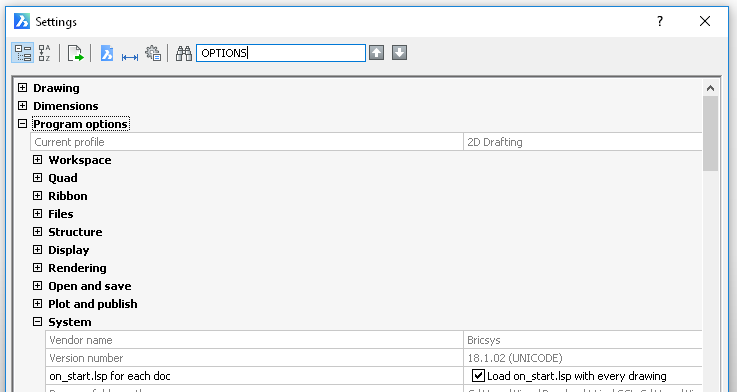
- #AUTOCAD LISP FILES HOW TO#
- #AUTOCAD LISP FILES CODE#
If you do not specify an output file, vlisp-compile names the output with the same name as the input file, but replaces the extension with. out-filenameĪ string identifying the compiled output file. If the source file is in the AutoCAD Support File Search Path, you can omit the path when specifying the file name. The compiler mode, which can be one of the following symbols : stĪ string identifying the AutoLISP source file. Note: The Visual LISP IDE must be open in order for vlisp-compile to work.

#AUTOCAD LISP FILES CODE#
Let's have a look at the syntax for (vlisp-compile) : vlisp-compileĬompiles AutoLISP source code into a FAS file (vlisp-compile 'mode filename ) This file should be located in the same directory as your AutoLisp source file. If compilation is successful, as in the example above, the Build Output window displays the name of the compiled output file. If the compiler displays warning or error messages, you can view and edit the source code that caused these messages by double-clicking on the message in the Build Output window. The compiler issues warnings if it encounters expressions it considers dangerous, such as redefining existing AutoLISP functions or assigning new values to protected symbols. If the compiler encounters errors, it issues messages and halts the compilation process. The first stage is syntax and lexical checking of the source code. Have look at the Build Output window : (COMPILE-FILES st (D:/drawings/slot.lsp))ĭuring compilation, the compiler prints function names and various messages about each stage of compilation. Now fire up AutoCAD and open the Visual Lisp Editor. (setq pt1 (getpoint "\nInsertion point: ")) (setq diam (getdist "\nSlot Diameter : ")

(defun C:SLOT (/ oldsnap diam lngth pt1 pt2 pt3 pt4 pt5 pt6) Let's start off this Tutorial by compiling a single AutoLisp file.Ĭopy and paste this into Notepad and save it as "Slot.lsp" :
If you have an AutoLisp file with dependencies such as DCL or TXT files, compile it as an Executable Visual Lisp Module VLX file. If you have a single AutoLisp file, compile it as a FAS file. So, let's try and give you a digest of what we've just discussed : VLX files can include additional resources files, such as VBA, DCL and TXT files, as well as compiled AutoLISP code. VLISP also provides features for packaging more complex AutoLISP applications into VLISP executable ( VLX) files. Even strings and symbol names are encrypted by the VLISP file compiler. Because the executable files contain only machine-readable code, the source code you spent weeks or months developing remains hidden even if you distribute your program to thousands of users. These executable files are known as FAS files. VLISP provides a compiler that generates executable machine code files from your source files. Once you are sure your program is working correctly, translating AutoLISP source code each time it loads is time-consuming. This is useful for quickly testing new code, and for debugging that code. The advantage of having source code translated each time you load it is that you can make a change and immediately try it out. Before we start with various methods of compiling AutoLisp files, let's have a look at the different file types we'll encounter during this Tutorial : LSPĬontains definitions of AutoCAD Dialog Boxesĭefines the files and options used to build a vlx moduleĮach time you load AutoLISP source code, the code is translated into instructions the computer understands (executable code). Restart DraftSight or Open New file startup.lsp file will load automatically. Go to Tools > Options > File Locations > System > Expand section ‘Support Files Search Path’, On righ side click on New tab and Browse and select folder D:\LISP Files (Move up this path) > Apply and Ok. As you have Created startup.lsp file and saved on path D:\LISP Files, assign this path in Support file search path. Use this method in order to automatically load above file when we open new or existing Drawing file in DraftSight. Tip: You can drag and drop LISP file inside DraftSight GA. 
Practice: Try with different location of LISP files. Now, If Alert message pop up then we are doing Great!.
 This code means Load startup.lsp file in folder LISP Files Located on D drive. To load above created LISP file in DraftSight write this following code in command line. Save file with name ‘ startup.lsp‘ in of your computer (Lets say in D: drive > ‘LISP Files’ folder). Write alert code from Previous Chapter as (alert “This is my first alert Message.” “DraftSight alert” “INFORMATION”). lsp format (use Notepad++ to create LISP file and save as. First of all Create a text file and save it as.
This code means Load startup.lsp file in folder LISP Files Located on D drive. To load above created LISP file in DraftSight write this following code in command line. Save file with name ‘ startup.lsp‘ in of your computer (Lets say in D: drive > ‘LISP Files’ folder). Write alert code from Previous Chapter as (alert “This is my first alert Message.” “DraftSight alert” “INFORMATION”). lsp format (use Notepad++ to create LISP file and save as. First of all Create a text file and save it as. #AUTOCAD LISP FILES HOW TO#
How to Create LISP file ? (File extension.








 0 kommentar(er)
0 kommentar(er)
